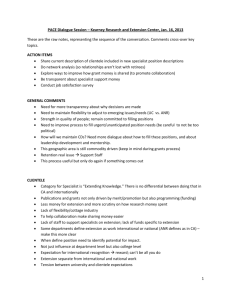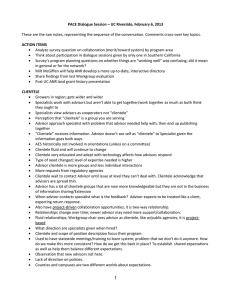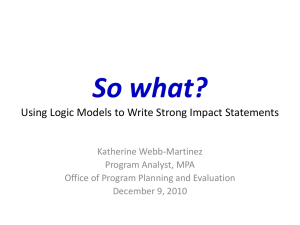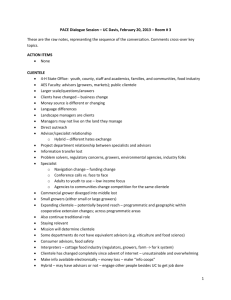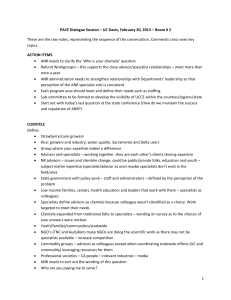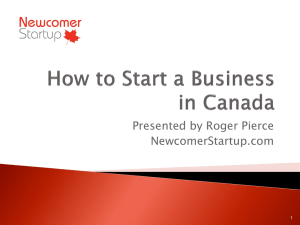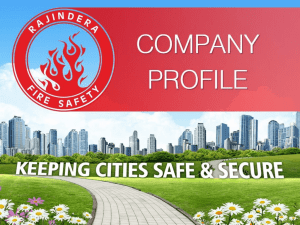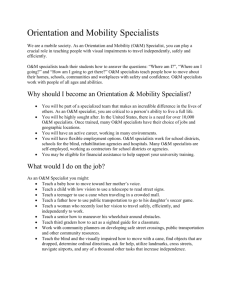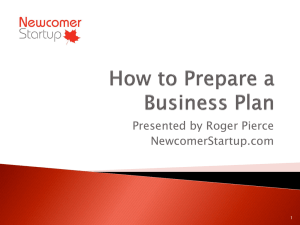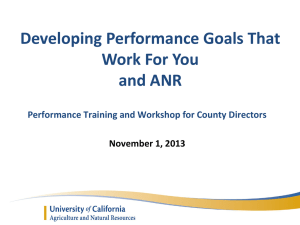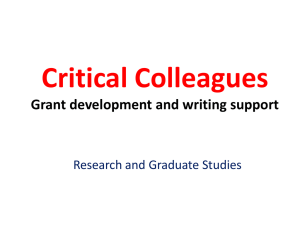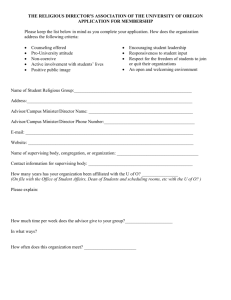UC Berkeley Recorded Comments
advertisement
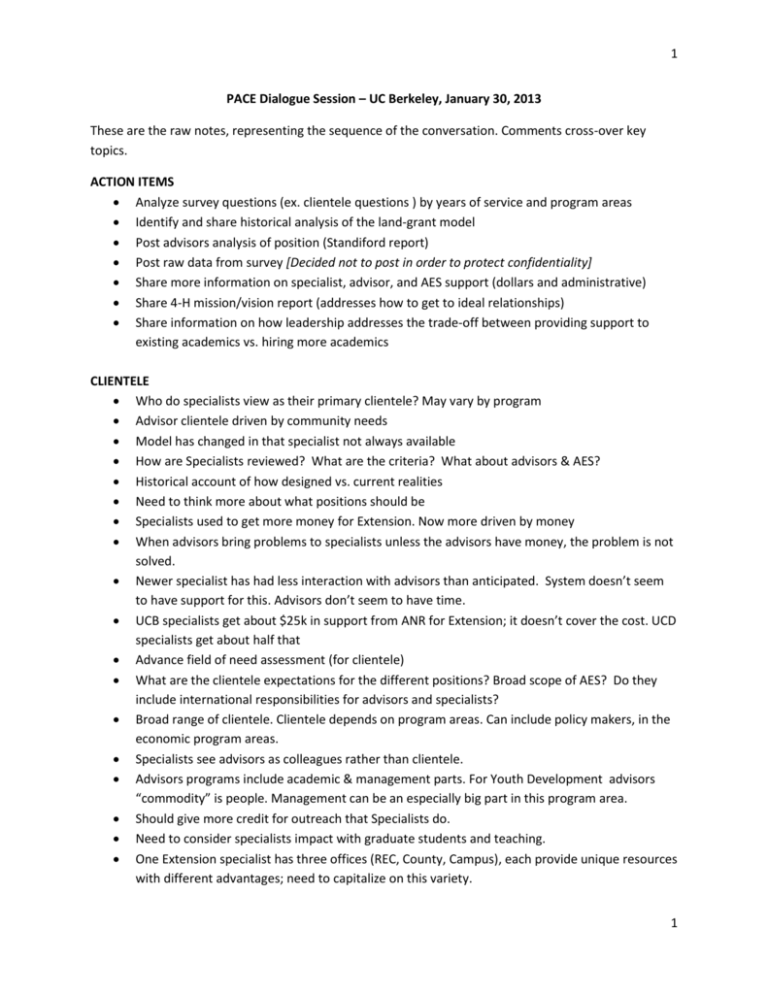
1 PACE Dialogue Session – UC Berkeley, January 30, 2013 These are the raw notes, representing the sequence of the conversation. Comments cross-over key topics. ACTION ITEMS Analyze survey questions (ex. clientele questions ) by years of service and program areas Identify and share historical analysis of the land-grant model Post advisors analysis of position (Standiford report) Post raw data from survey [Decided not to post in order to protect confidentiality] Share more information on specialist, advisor, and AES support (dollars and administrative) Share 4-H mission/vision report (addresses how to get to ideal relationships) Share information on how leadership addresses the trade-off between providing support to existing academics vs. hiring more academics CLIENTELE Who do specialists view as their primary clientele? May vary by program Advisor clientele driven by community needs Model has changed in that specialist not always available How are Specialists reviewed? What are the criteria? What about advisors & AES? Historical account of how designed vs. current realities Need to think more about what positions should be Specialists used to get more money for Extension. Now more driven by money When advisors bring problems to specialists unless the advisors have money, the problem is not solved. Newer specialist has had less interaction with advisors than anticipated. System doesn’t seem to have support for this. Advisors don’t seem to have time. UCB specialists get about $25k in support from ANR for Extension; it doesn’t cover the cost. UCD specialists get about half that Advance field of need assessment (for clientele) What are the clientele expectations for the different positions? Broad scope of AES? Do they include international responsibilities for advisors and specialists? Broad range of clientele. Clientele depends on program areas. Can include policy makers, in the economic program areas. Specialists see advisors as colleagues rather than clientele. Advisors programs include academic & management parts. For Youth Development advisors “commodity” is people. Management can be an especially big part in this program area. Should give more credit for outreach that Specialists do. Need to consider specialists impact with graduate students and teaching. One Extension specialist has three offices (REC, County, Campus), each provide unique resources with different advantages; need to capitalize on this variety. 1 2 Rubs specialist wrong way to think of advisor as clientele; not about who is in charge but about working together to solve community problems. Take county questions seriously. Challenged by lack of travel budgets to work on county/local projects. 4-H Advisors/CDs don’t define clientele so much; given to them by club programs. Pre-defined, less academic freedom. Advisors and CDs have to find support money and administrative support from county government. What is the new “junior specialist” position role? It is an academic title. There is a range of “specialist” titles in the APM not connected to ANR mission. Specialist thinks of AES as clientele. Often referred to for ways to help AES fulfill their roles with outreach; need to identify these opportunities. AES clientele are agencies and NGOs When advisors produce research-driven, applied outreach materials (ex. curricula) fulfilling both academic and management role Advisors create programs to serve clientele; doesn’t think specialists think about “serving” advisors in that same way Specialists like being on campus to work with students and teach; those students engaged in community connections; this should be in discussion. **GSE: Graduate Student in Extension; specialists see students as critical for getting program/continuum really going. This new position can be incentive for specialists and advisors to collaborate. Win-win. Students engaged and have great opportunities for real world application); could also help with advisor recruitment. **Proposal to throw our “continuum”; network more applicable; get rid of hierarchy and identify nodes Ex. of specialists and advisors working well together; “Money Talks”; Specialist created environment without hierarchy and was multidisciplinary group Urban-rural continuum still work in progress (ex. IPM lack of urban footprint) **With IT easier for all position types to contact each other and work together with clientele; broadens clientele from just being identified as local Clientele in farming program area very knowledgeable/skillful Need a new model where appropriate provide fee for service Look again at how to link ANR to the coast (some Extension programs lost with Sea Grant move to UCSD) Having county offices near campus have challenge to explain different roles to public; sometime overlap (ex. Bay Area) Build new/more relationship with foundations for funding opportunities to support collaborations Should address “Volunteer Management” as own program With expansion of IT opportunities, there is growing, “reverse” demand for hands-on learning (new trend). 2 3 How is our Ag program more than a form of industrial welfare? o Was mandated by Congress. Salary parity issue benefitted from specialist on campus; would be affected by locating off campus Does advisor work being more like specialists work adversely affect this parity issue? Specialist and advisors don’t have equivalent status. Don’t get automatic increases like faculty. Almost got adjustment in 2007, but then had new cuts and a new Provost. Groundwork is done. ROLES, RESPONSIBILITIES, AND COLLABORATION UCB specialists have community clientele and expectation to teach = spread too thin. Why only here? There are differences with adjunct status between colleges/schools. Specialists located on RECs don’t need to dedicate time to department responsibilities; can focus more on research and extension. Department expectations and culture vary Is “lecturer without salary” available at UCB like UCD? UCB changed how funded AES (17.5 years ago). Now 9-month instead of 11-month appointment. Also now true for UCD. AES now get zero support funding. UCB has two people with AES/CE/I & R splits. What could help Advisors work more closely with Specialists to move toward ideal relationship? More time. (Suggestion: another survey on this topic.) Have been asked this many times; requests never in budget; understanding constraints could help frame). Trade-off: add more support to existing academics vs. adding more academics; need balanced allocation approach Need to support existing programs (ex. Master Gardener Program) in UCCE, as well as centers on campuses Advisors/CDs heard critique from clientele over that years that academic programs were being developed top down; it is better to include clientele in the program development phase Hard to find ANR colleagues to collaborate; need better mechanism. SRAs: need help to find people and capitalize on ANR network Highlight successful network (ex. “Putting Youth on the Map”) Role of AES? Captured in merit and promotion process and/or practice? o Used to get $30k for research, now gone. Previous UCB support money for AES from salary pool during hiring freeze (not ANR). o Only expectation is to fill out form related to salary; disconnect to ANR mission o Campus does evaluate based on service; that is still expected o Need to build culture of expectation within department and college. o No other AES nationwide as successful as us with competitive grants – demonstrates our success. o AES “service” roles not just work with UCCE but also serve agencies, on boards, etc. 3 4 What is the ideal relationship/network? More network with nodes (include stakeholders) than continuum; specialists don’t need to be conduit flexibility with how to connect Advisor, Specialist, AES; better able to take on emerging problems. Listed expertise areas don’t capture true interests; mechanism to connect people by latter Ideal collaborations resolve around common interests and passions ANR competitive grants program has worked well Opportunity to collaborate on various publications types. Identify shared benefits/outcomes; start collaboration early not at end. Took issue with large ANR grants given lack of support funds; ANR in business of starting things – benefits from small grants. Some program areas missing from ANR grants call (ex. Animal Ag). Review process needs to be taken more seriously. Need to acknowledge that science does take a lot of money; need large grants. Some advisor programs have been able to secure small grants repeatedly over the years to create/sustain successful research AES faculty need more money than ANR could ever provide for their research (a constraint) Physical distances can also be a constraint for collaboration. PROGRAM PLANNING Strategic Initiatives can work well for people working in those areas; some areas missing (ex. environmental horticulture and atmospheric sciences) Seems like Strategic Initiatives have morphed from original intent. Should revisit if intent was to catalyze collaborations How do we measure Strategic Initiatives’ success? Miss Continuing Conferences Positions/FTE linked to Strategic Initiatives can be problematic if gap doesn’t fall under Strategic Initiative area; new needs could be missed. Program Team challenge: translate getting together once a year into an ongoing meaningful collaboration Expectation for outcome of policy brief is a challenge given it doesn’t have experience in this area; need more guidance. Work groups worked well. They held certain days for this work. Strategic Initiatives might be trying to do much. Strategic Initiatives identified priority areas provide direction rather than trying to be everything to everyone; Framework for outcomes. Some Strategic Initiatives have identified and catalyzed people working together on new issues (ex. Urban Ag). Strategic Initiatives helped new Advisors identify potential collaborators 4 5 How are Workgroups and Strategic Initiatives working for campus-based academics? Forestry workgroup has geography challenge (spread out statewide) Highly variable for AES to connect to Workgroups. Depends on program area and expectations. Departments need to have relevance rather than each individual. How do you reward /incentivize people who do engage and function as bridges back? For advisors, Workgroups worked well for collegiality and ideas exchange with campus Maybe Workgroup preference is due to fact people still trying to figure out Program Teams and Strategic Initiatives What do you think about locating specialists off campus? Two options: Department affiliation or not What about locating off campus with no department affiliation, but with REC affiliation? Pluses: less committee work not relevant to primary work; Minuses: May not have as much interaction with potential collaborators. But, may be closer to needs. Success depends on subject area and individual. Shouldn’t/can’t cover this topic with broad brush. There just need to be nodes of critical mass. Can’t just be dispersed statewide. Need to build capacity wherever are. Need collegiality. Consider USDA model. Specialist evaluation varies by Dept. How will off campus location affect Specialist evaluation? Think outside the box more broadly in terms of locations of all positions. In Advisor/Specialist collaboration. Specialist location didn’t matter; about shared expertise both ways. “It depends” answers all the questions on this topic. Some program areas need campus for labs and graduate students. Time constraint to get off campus; Embedding in other organizations has good and bad; gravitational attraction. Why not call off campus specialist to Advisor series? If specialist off campus could get behind overtime (continuing education) Time constraint to get off campus. Embedding our academics in other organizations has both good and bad. Why not title off-campus specialists using advisor series If specialists are located off campus they could get behind overtime, due t less access to continuing education We need to think about ANR’s image & communicate our benefit to the sate given the ongoing budget cuts A lot of AES continue to do the mission without tangible incentive. Seems to be a bad perception of having ANR academics located on campus; but there are example of where this is working well Have ANR extend to more than our three campuses, given UC wide ANR’s presence is small. The increased specialist focus on campus is not the cause of the breakdown in interaction. It is the outcome of the squeezing of the whole system. 5 6 Advisors with PhDs functioning as specialists from whom fellow advisors seek input What ways are there to maintain cutting edge science, especially if less on campus? All positions are doing cutting edge science. Some advisors do have graduate students (not just from UC). Review of ANR indicated we have the best advisors, specialists, and AES nationwide; something is working. Need to focus on recruiting and retaining the best. CNR departments review recommended capitalize more on Extension, given graduate student interest. Specialists could use/get more graduate students. Need to make sure network includes meaningful collaborations. It is not about getting the different titles; but rather about having the necessary expertise ANR’s network could have more campuses as nodes; limited with 2 in Northern CA and 1 in Southern CA. Can collaborate with other UC campuses even if not formally part of ANR Specialist are expected to and are bringing real life problems to campus to inform AES research We have a strong organization, just need to determine how to strengthen. No matter how great campus-based work is, we need to communicate our community outcomes to CA voters. Meeting Evaluation + What Worked Well Having college leadership participate Great mix of people Food Small group size Great moderator; good recapping Good hand-writing for recording Great opportunity to discuss roles to help build shared understanding Gorgeous facility and view ++ What Would Make It Better Have advisor, specialist, and AES position definition at start Send out or post agenda ahead of time More coffee Use column graphs instead of pie charts Have more county advisors attend 6
